There’s nothing better than a one pan chicken dinner! These Cast Iron Skillet Chicken Thighs are easy, delicious, and clean-up is a breeze!
The chicken turns beautifully golden and crispy on the outside while staying juicy inside. The vegetables soak up all the savory juices and the mustard maple glaze. This cast iron skillet chicken thighs recipe is as cozy as my Dutch Oven Chicken, but a lot easier!

A cast iron skillet is ideal for this chicken thighs recipe because it holds high, steady heat, helping the chicken develop a beautiful golden brown crust. The skin never sticks to the pan and the chicken always turns out juicy and tender!
The best part is that you can turn these cast iron skillet chicken thighs into a beautiful one pan meal. You can use any vegetables you like or switch it up depending on the season. In the fall, I love using butternut squash and Brussels sprouts. If you love my Butternut Squash and Brussels Sprouts recipe, I think you’ll love this one too!
Everything comes together in under 40 minutes, making it perfect for busy weeknights or slower Sundays at home. These skillet chicken thighs are just as simple as my Honey Mustard Chicken or Pork Chops with Apples and Onions.
Jump to:
Why I Love This Recipe
- Crispy skin: Cooking in cast iron is perfect for achieving the perfect crispy, golden brown crust on the chicken skin.
- Easy one pan recipe. Everything cooks together in the same skillet allowing easy clean up. It starts over the stovetop and finishes cooking in the oven.
- Flavorful chicken. The chicken is generously seasoned and brushed with a maple-mustard glaze at the end. And all the drippings soak into the veggies as it cooks!
- Seasonal vegetables. For this skillet chicken thighs recipe, you can use anything that’s in season.
One Pan Chicken Dinner
This cast iron chicken thighs recipe is perfect to customize with whatever vegetables you have on hand for a wonderful one pan dinner!
Fall: Butternut squash, Brussels sprouts, carrots, sweet potatoes.
Winter: Root vegetables like potatoes or parsnips, or hearty greens such as kale and cabbage.
Spring: Asparagus, baby potatoes, leeks, and peas for something fresh and light.
Summer: Zucchini, bell peppers, cherry tomatoes, and green beans.
Ingredient Notes
I hope these ingredient notes from recipe testing are helpful when picking up your ingredients!
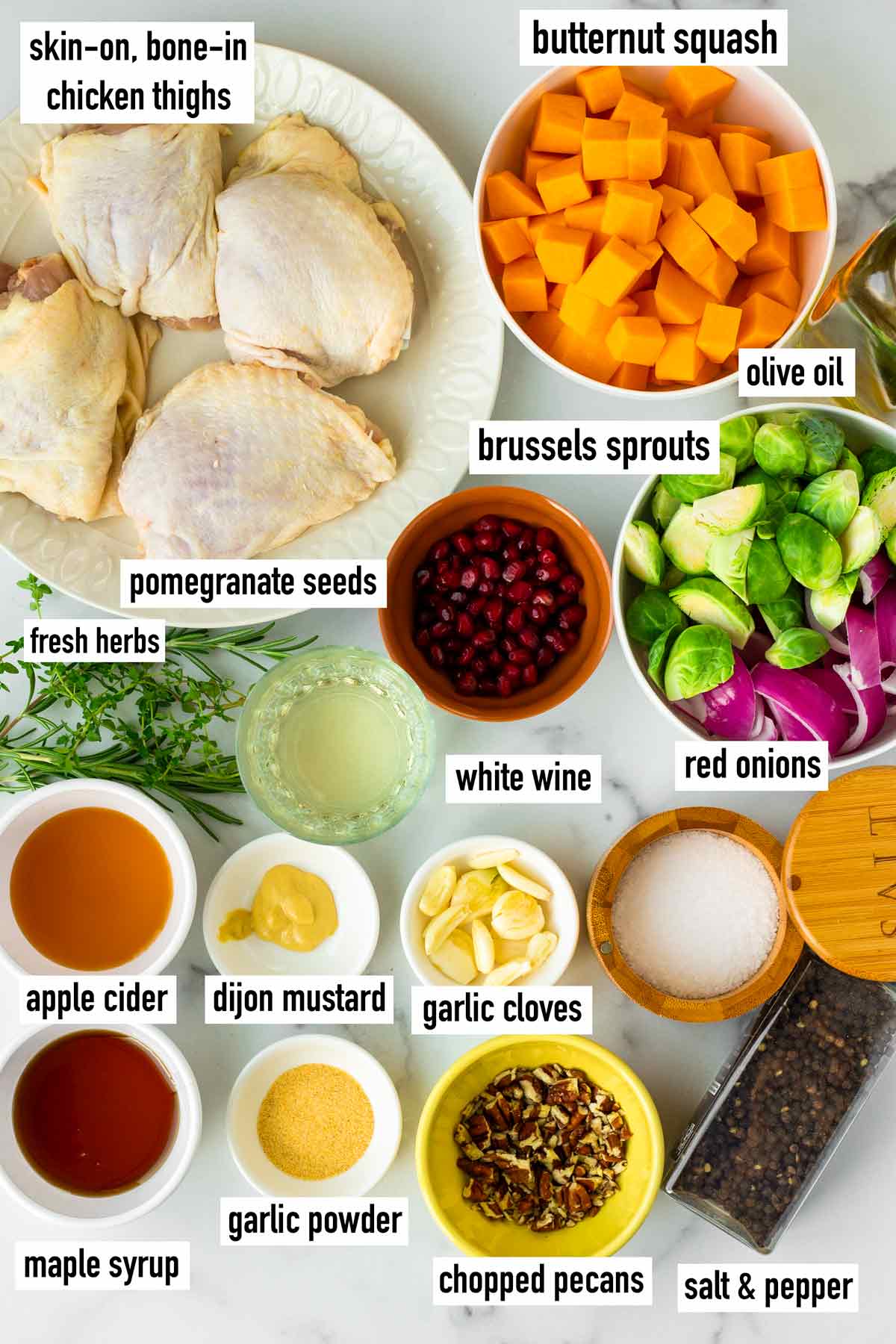
- Bone-in chicken thighs: I’d recommend skin-on bone-in chicken thighs. The cast iron skillet does a great job searing the skin and making it really crispy. However you can also use boneless chicken thighs (they cook faster).
- Brussels sprouts and butternut squash: Two of my favorite fall vegetables! The sweetness of the squash balances the natural bitter tones from the Brussels sprouts. Plus the color contrast is so pretty!
- Onions and garlic: Yellow or red onions. For the garlic, I just smash garlic cloves, but you can also mince them.
- Fresh rosemary and thyme: Used to season the chicken and for roasting along with the vegetables. They add really nice, herby and earthy flavors.
- White wine: To deglaze. If you’d like, substitute with chicken broth.
- For the glaze: Maple syrup, apple cider (the beverage, not the vinegar), and dijon mustard. If you can’t find apple cider, you can use unfiltered apple juice.
- Pomegranate seeds and chopped pecans for garnish
- Olive oil, salt, pepper, garlic powder
As usual, the ingredient quantities can be found in the recipe card down below.
How to Cook Chicken Thighs In Cast Iron

Step 1: Preheat oven to 400 degrees F. Pat chicken dry thoroughly first. Season chicken with about 2 tablespoons olive oil, minced rosemary, garlic powder, salt and pepper. Let rest 15 minutes for the flavors to absorb while you prep the rest.

Step 2: Heat a large 12-inch cast iron skillet, then heat a few generous drizzles of olive oil. Sear the chicken skin side down, undisturbed, for 6-7 minutes. You know it’s ready to flip when it releases easily – this means it has that nice golden brown crust. Sear the other side for another 3 minutes. Remove from the skillet.
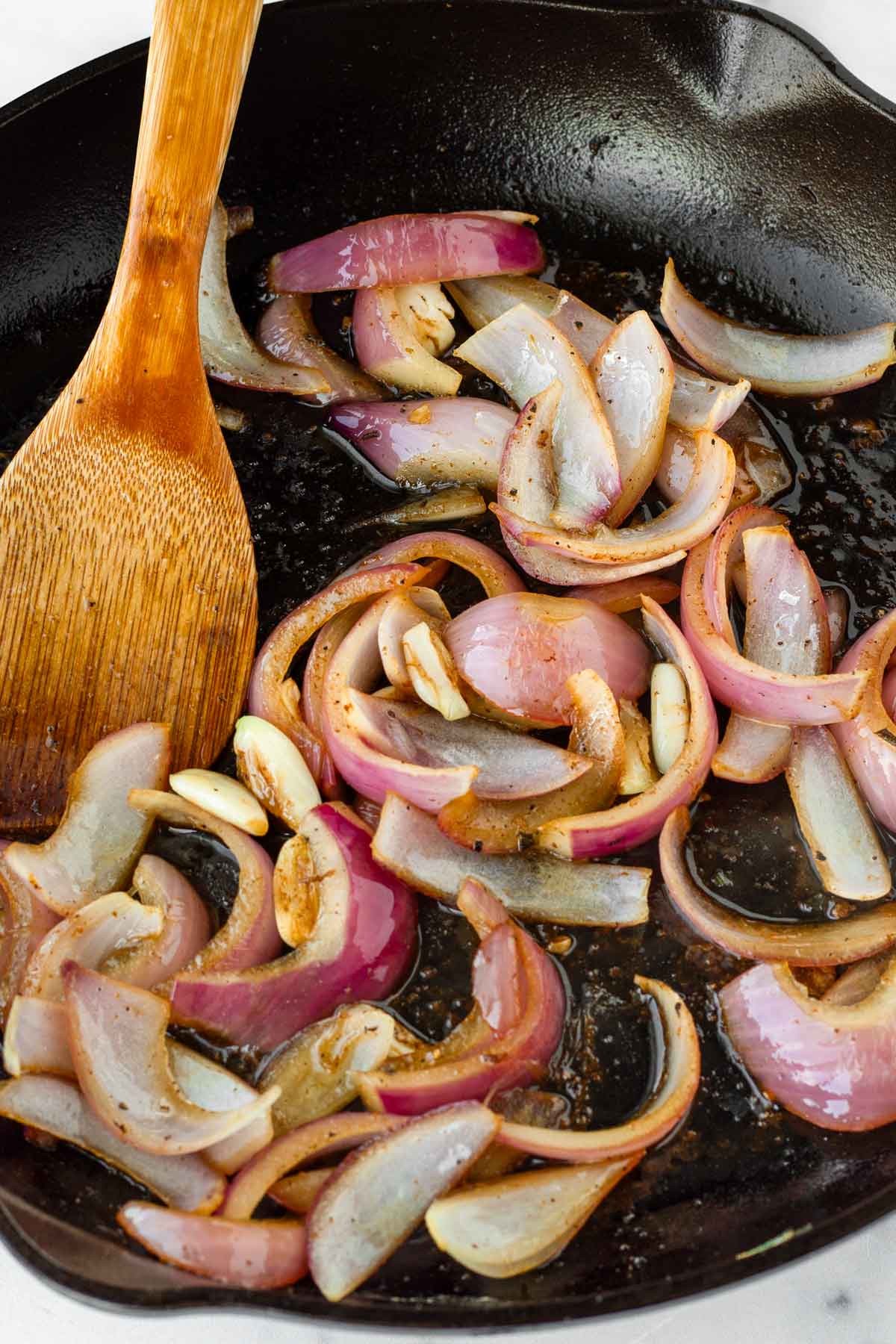
Step 3: In the same skillet (do not wipe clean), sauté sliced onions and smashed garlic cloves for 3 minutes, then deglaze the skillet with half of the white wine.

Step 4: Add the butternut squash and Brussels sprouts, and sauté for about 5 minutes. Season with salt and pepper. Then, deglaze with the remaining wine.
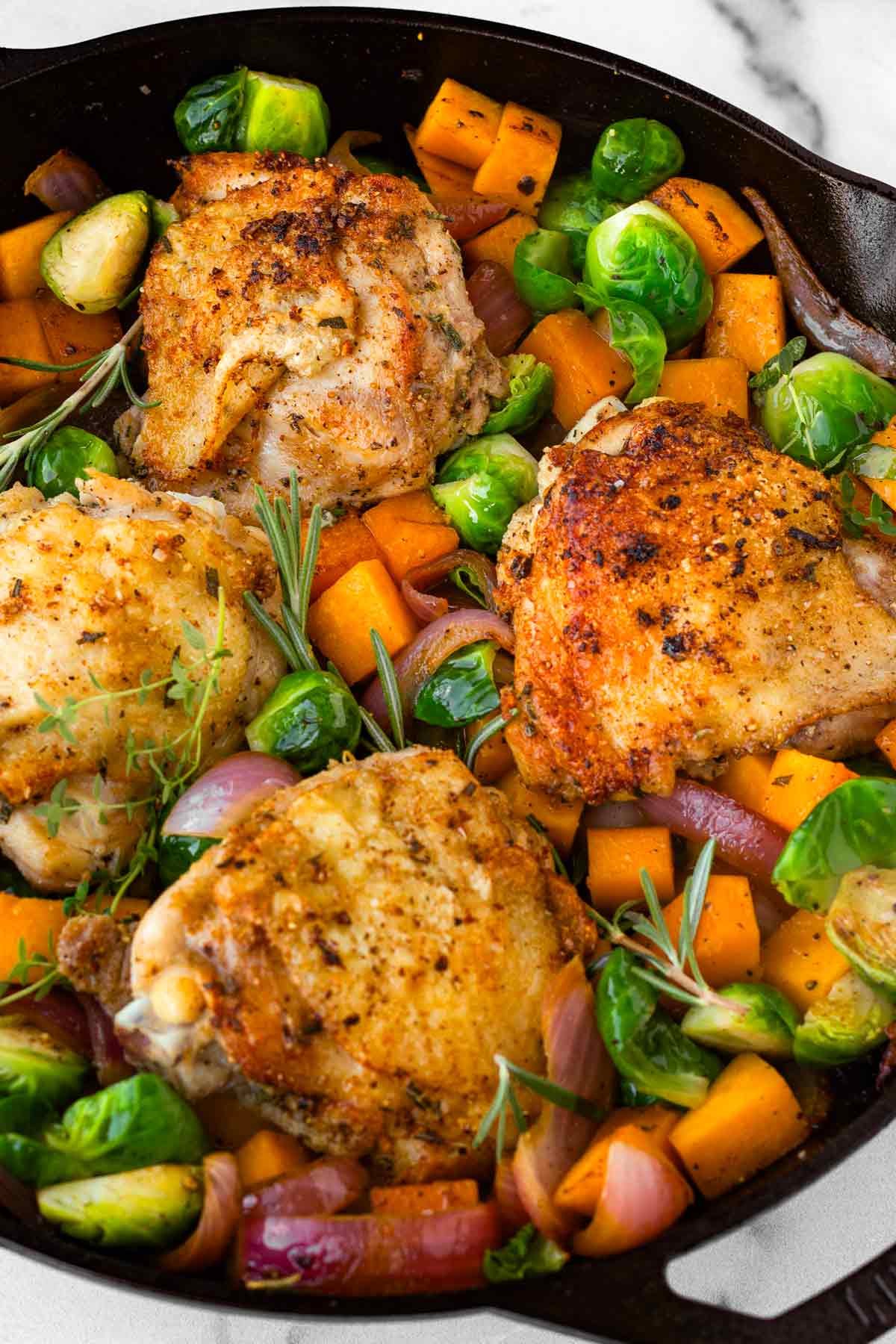
Step 5: Return the chicken, nestling them around the vegetables. Add rosemary and thyme sprigs, then finish cooking in the oven for about 20-25 minutes. During the final 10 minutes, brush with the glaze (maple syrup, dijon mustard, apple cider) until caramelized.
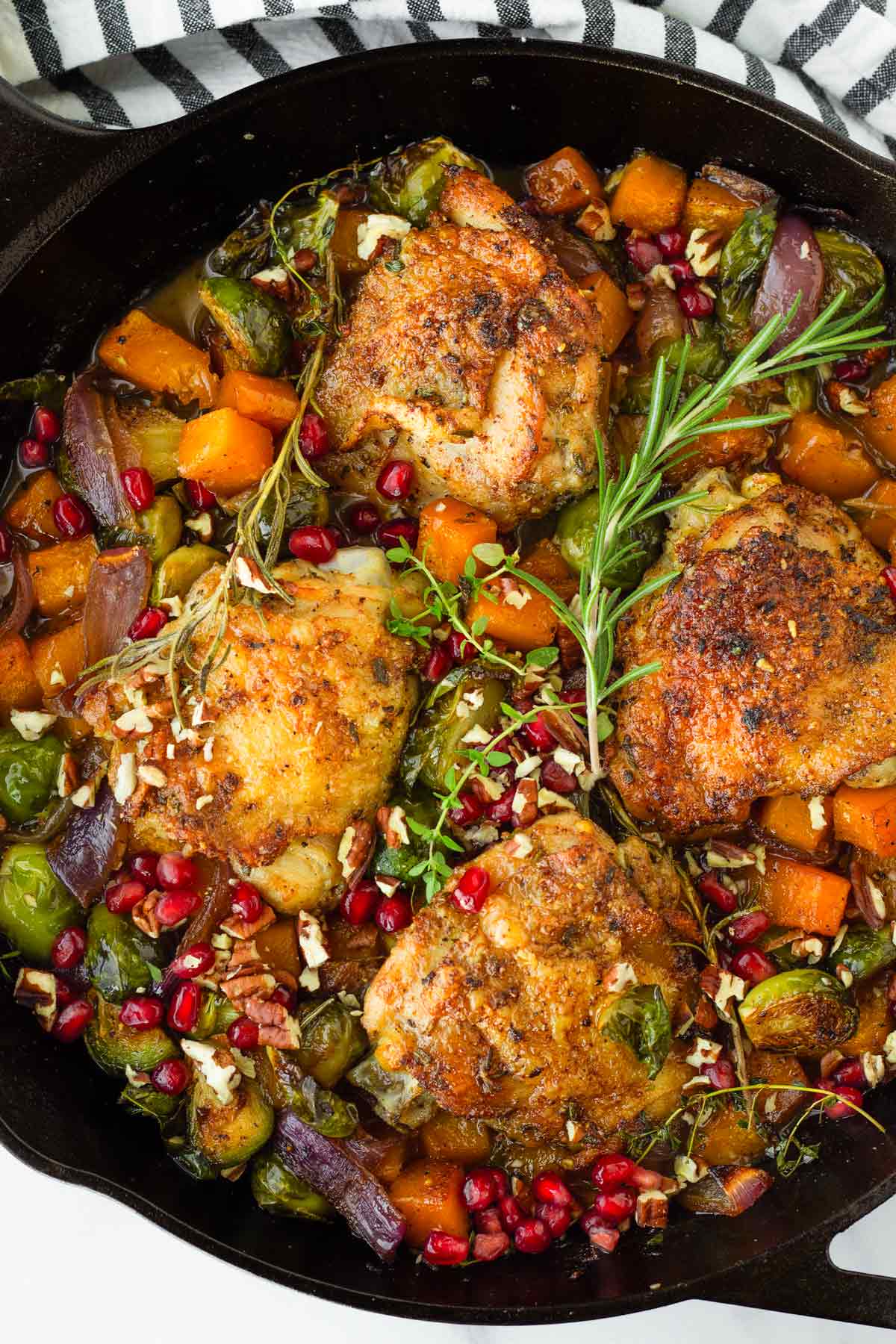
Step 6: Garnish with pomegranate seeds or chopped pecans. And that’s it! These cast iron skillet chicken thighs are amazing!
Tips for Success
- Pat chicken dry thoroughly before seasoning. Too much moisture will prevent the chicken from getting a golden sear.
- Use skin-on and bone-in chicken thighs. They stay juicy and the skin develops a really nice, crispy golden brown crust in the cast iron skillet.
- Use medium-high heat to get that perfect crust, and sear undisturbed to get that perfect crust.
- When to flip chicken: Flip only once the skin releases easily from the pan and is deeply golden brown, about 6 to 8 minutes. If it sticks, it’s likely it’s not ready yet.
- Deglazing with wine! This step unlocks all those flavor-packed brown bites from the pan and adds tons of flavor. If you prefer not to use wine, substitute with chicken broth.
- Brush with glaze only during the final 10 minutes to prevent the maple syrup from burning.
Prep Ahead Tips
This skillet chicken thighs is best cooked and served fresh so you can get the best of the crispy and tender textures, but you can prep the ingredients ahead.
Prep ahead: Season the chicken as directed, then refrigerate overnight. Chop and cut up the vegetables and garlic.
Make ahead and storage: Once cooked, it will keep in the fridge for up to 3 days. Reheat in the oven at 350 degrees F, microwave, or on the stovetop until warmed through.
Recipe FAQs
After searing for about 6-7 minutes in the cast iron skillet, they need about 20-25 minutes in the oven depending on how thick they are.
I use a large 12-inch cast iron skillet.
Yes! Sear them for about 3 minutes per side, then finish cooking in the oven for closer to 20 minutes. They cook faster than bone-in.
Yes, you can use any large oven safe skillet, but of course cast iron is highly recommended for this recipe.
Pairing and Serving Ideas
I’d love to hear from you! If you loved my recipe, please consider leaving a 5-star rating and a comment down below. Sign up for my newsletter and follow along on Instagram, Facebook, or Pinterest
Cast Iron Skillet Chicken Thighs
Equipment
Ingredients
- 4 chicken thighs, skin-on and bone-in - about 2 pounds, excess fat trimmed
- 2 teaspoons minced fresh rosemary - or ½ teaspoon dried
- 1 ½ teaspoons garlic powder
- Olive oil
- 1 medium red onion - thick sliced
- 8 medium cloves garlic - peeled and smashed
- ½ cup white wine - or chicken broth
- 1 ½ cups brussels sprouts - trimmed and quartered
- 1 ½ cups butternut squash - peeled and cut into ½ inch cubes
- 4 sprigs of fresh rosemary and thyme
- Salt and pepper
- Pomegranate seeds - for garnish
- Chopped pecans - for garnish
Mustard maple glaze:
- 3 tablespoons maple syrup
- 1 teaspoon dijon mustard
- 2 tablespoons apple cider (optional) - not apple cider vinegar
Instructions
- Preheat oven to 400 degrees F.
- Season chicken: In a large bowl, rub the chicken with fresh minced rosemary, garlic powder, Kosher salt (1 ½ teaspoons), and black pepper (½ tsp), and 2 tablespoons olive oil . Let them rest for 15 minutes to let all the flavors in while you prep the rest.
- Sear chicken: Heat a large 12-inch cast iron skillet over medium-heat, then heat a few drizzles of olive oil. Sear the chicken skin side down first, about 6-7 minutes. Once a golden brown crust forms, it will release pretty easily from the pan – if not, give it a few more minutes or until golden. Then, sear the other side for another 3 minutes. Remove chicken from the skillet.
- Sauté onions and garlic (aromatics): In the same skillet, sauté the onions and smashed garlic cloves for just 2-3 minutes, then deglaze with half of the white, scraping any brown bits.
- Add the veggies: Add the Brussels sprouts and butternut squash. Sauté them for about 5 minutes. Deglaze pan with the remaining wine. Season with salt and pepper to taste.
- Finish in the oven and glaze: Return the seared chicken into the skillet, skin side up, nestling them around the veggies. Add rosemary sprigs, gently pushing them down. Transfer to the oven and finish cooking for 20-25 minutes until internal temp reaches 175 F. During the last 8-10 minutes, brush with the mustard-maple glaze (whisk maple syrup, dijon mustard and apple cider) every 3-5 minutes or so, until caramelized and glossy.
- Garnish and serve: Let it rest for 5 minutes before serving. Garnish with pomegranate seeds and chopped pecans. Enjoy!
Notes
- Sear undisturbed: Let the chicken cook skin side down without moving it until it naturally releases from the skillet, about 6 to 8 minutes. This ensures a golden, crispy crust.
- When to flip chicken: Turn the chicken when the skin is deep golden brown and releases easily. If it still sticks too much, give it another minute or two.
- The glaze: If you can’t find apple cider, just omit it. Glaze with a mix of maple syrup and mustard.
- Add glaze towards the end so it all caramelizes without burning. Reapply once or twice for a glossy finish.
- The chicken is ready when a thermometer inserted in the center reaches 175 degrees F for thighs.
- Prep Ahead: The chicken can be seasoned 1-2 days ahead and refrigerated. You can also chop the vegetables and have them ready to go for cooking.
- Store leftovers in airtight containers for up to 3 days.
- Reheat in the microwave oven, in the oven at 350F oven, or in a skillet
- Spices: Feel free to add your favorite spices here! Smoked paprika is great.
- Bone-in chicken thighs: Boneless chicken thighs (they will cook a bit faster
- White wine: Chicken broth
- Other vegetable ideas for the skillet:
- Fall: Butternut squash, Brussels sprouts, carrots, sweet potatoes.
- Winter: Root vegetables like potatoes or parsnips, or hearty greens such as kale and cabbage.
- Spring: Asparagus, baby potatoes, leeks, and peas for something fresh and light.
- Summer: Zucchini, bell peppers, cherry tomatoes, and green beans.


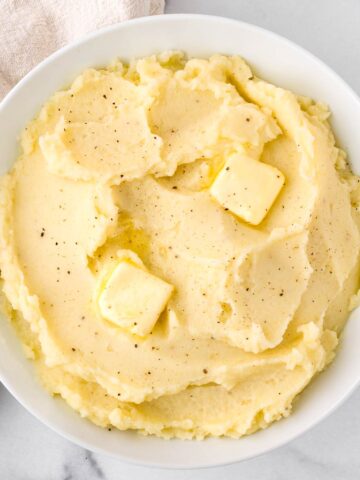



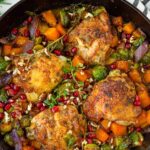
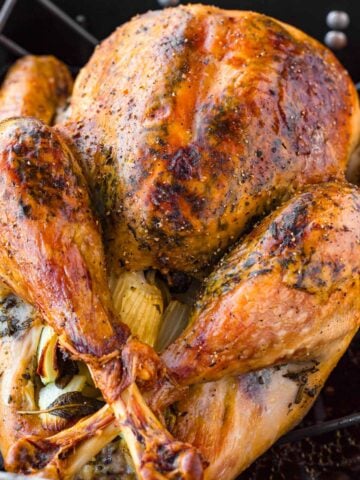
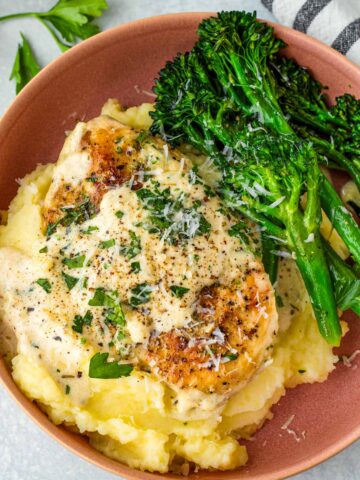
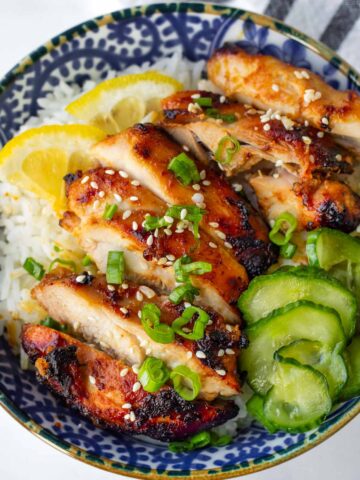
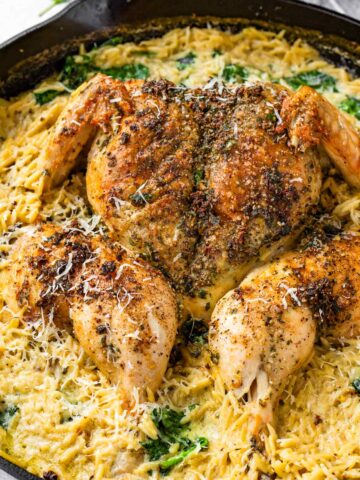


Mark E says
Loved the flavors. The glaze was really good. I used acorn squash instead and cooked a little less time since the chicken thighs I got were on the smaller side. Easy recipe and served over rice. Thank you.